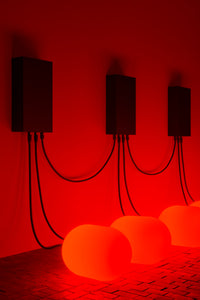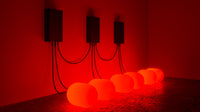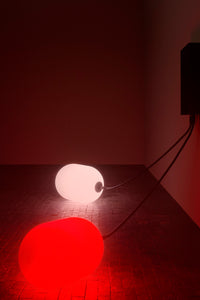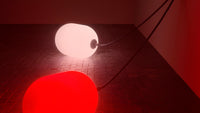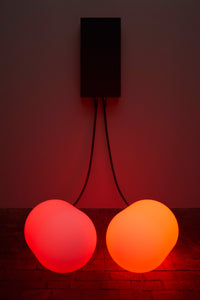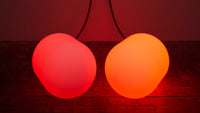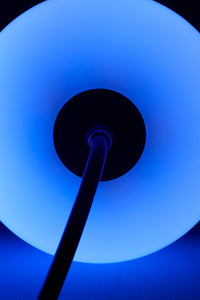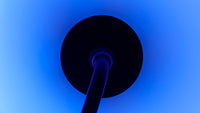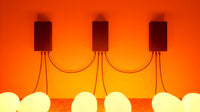Everything but the world, Centre d'art Cotemporain
Biennial for the Moving Image Geneva, 2021
For the Biennalle de l'Image en Mouvement, co-curated by Andrea Bellini and DIS, Timon & Melchior Grau present Fire, a series of dynamic sculptures that create strong, irregular light atmospheres. Fire uses the transformative power of light to influence the relationship between people, objects and space. The light sculptures guide visitors through the exhibition over four floors of the museum. Visitors are invited to return again and again to extreme Light- and dark conditions, colors and moods as they move through the corridors and into the individual exhibition rooms.
A conversation between DIS and Timon & Melchior Grau
DIS Your work for the biennial, Fire (2021) is a series of light sculptures - which function almost as performances. At times these bulbs, which you've described as single LED pixels blown up to a massive scale, feel like a heartbeat and others like dawn. The work guides us through the exhibition, we are asked to adapt over and over again - to extreme light and dark, colors, temperatures, mood swings as you move through the corridors and into each artist room. When you were creating the light performances what were you imagining that experience would be like?
GRAU Through the use of immersive light sources we aim to activate the human's capacity to feel, remember and reconnect. We believe that light is a vessel for values, because it makes a difference how we look at things. With the Fire sculptures we want the visitors to be the center of the experience, to take them inside the moving image, inside the fire, inside the womb, inside the dream. At BIM we treated the spaces as if we were designing a video game, using the light sources as focus points, as guiding elements through the exhibition. The visitors can make their own choices in this framework, they are confronted with these spaces and with their own reflections.
As a trigger of the experience the sculptures are your counterpart, like friends, like wonders, like flashing neurons, like giant pixels or pulsating organs. They inhabit the space together with you. They shape your own experiences, but are independent from you. They are neither offending, nor ignoring you. The Fire sculptures all represent different characters: Choose to change today confronts you with ambivalence and the acceptance of change. Kiss is intimate and is about embracing openness. Burn from both ends is so immersive that you can't escape the light. Like falling into the sun, going all in, bathing in light. And I am a believer feels to us like sneaking into someone's brain, like walking through a utopian landscape of lucid dreams.
That you and Andrea invited us to let our works shape the spaces between all these amazing video works in this biennale, was the best possible context for the Fire series, but also the biggest joy and honor for us. Thank you.
DIS We imagine the early cave paintings being lit by fire and the flickering of light creating the first moving images, so it makes sense to us that in a biennial about moving images the work most present is titled Fire. And interesting in this case that Fire is in the form of LEDs which today compose screen technology. Can you speak more about the origin of the work and its title?
GRAU It's nice that you comment on the early humans and their cave paintings. They are fascinating. Fire triggered the first example of moving images. We are interested in the elemental qualities of fire. The control of fire was one of the first and most impactful designs and dramatic change in the habits of early humans. Making fire to generate light and heat enabled people to evolve, creating visions of new possible futures but also to dominate the narrative on Planet Earth.
For us, fire is the perfect symbol of our ambivalence as Homo Sapiens. We humans are like fire, with all the ambiguity of construction and destruction. We are out of control, in the best way and in the worst way.
Over time, the human gained even more control over the relationship to their surroundings, abstracting from our connection to natural resources. In your film Everything But The World which you presented at BIM 21, you trace back the Homo Sapien's progress and ability to design, yet not as a linear straight line. More like a loop or network. How would you describe this development and evolution? Will we ever escape it?
DIS Everything But the World touches on how we've allowed complex systems to run rampant, becoming less visible and dividing us further from each other and the natural world we're apart of - not separate from. Every tool created a disconnect to imagining a time before it. So its interesting that you're thinking about the way lighting technology can link us back to fire through irregular, programmable light patterns.
GRAU Yes it's true, the fireplace, a candle or the sun are lights that we as humans deeply connect with. Think of the most beautiful sundown or a candle light dinner. These lights carry a spiritual quality and serve as carriers for spirits and beliefs. They inspire us to ask in what light we want to see the world. Think about all the sayings about light: See light at the end of the tunnel. Light a candle of hope. Your heart is on fire.
In contrast to these symbolic associations, we don ́t connect in the same way to artificial lights yet. In applied context light is mostly used as a pragmatic vehicle. With GRAU we want to change this. We love that light is in between things, shaping visceral experiences, creating emotional relationships. That's why we are interested in product design and more applied contexts, too, where we can get close to people. Applied spaces give a different time frame to the work, as people are living with it. Even if we are not aware of it, the light is constantly impacting your perception of life.
DIS Let's talk about the pixel, the digital pixel vs the analog pixel. The cathode pixel vs the cellphone pixel. The cathode pixel was always portrayed as something that you need to have some distance between you and it because it wasn't good for your eyes. But that rhetoric is gone with the digital pixel. Today's pixel has been getting closer and closer to us, VR glasses made for gaming and the metaverse, phones and computers adjust for brightness depending on our environment. These light sources accompany us everywhere. Is responsive light the lifestyle update we're all waiting for?
GRAU Pixels in moving images, video, VR, even the metaverse are actually tiny moving lights, together they become representative images, like representative paintings. This communication happens a lot at an intellectual level with a fictional reality in mind.
On the other hand, our light makes you part of the scene. We hope to reconnect your body with the brain, so recollections, connections and memories, can act more at a visceral level. In some ways we believe such light is closer to augmented reality since it is an enhancement of both the virtual and the real world. It can reconnect your experience with your physical surroundings, while virtualizing it at the same time.
Today the ever-faster rates of development and the introduction of new user experience technologies (UI, AI, VR, AR) in every aspect of daily life, have immunized us against our natural instincts, guiding intuitive choices and random experiences, covering the very unpredictability of life. Humans have created a virtual world. To look at the future, do we need to ensure human presence?
DIS When we began working on Everything But the World we wanted to see humanity on a totally different time-scale than our lived experience. Geological time. A pebble may take three million years to form, to compress itself into existence - so there will be a time after the "human". We were thinking a lot about the semiotics used in Nuclear Warnings, how to communicate to a distant future that's potentially post-language.
The whole conception of the "end of the world" is a human-centric fallacy built on our obsession with our own individual births and deaths. In the film this comes through strongly in the idea of prepping not for life but for death - for becoming a fossil.
We acknowledge that we're writing history. We are already in the past, so it's our position that we need to tell different stories for future generations. We have lied about the origin of money, of markets, divine kings - just about everything is a fiction.
On the last night in Geneva, you gave us copies of "Are we human? Notes on an archaeology of design" by Beatriz Colomina and Mark Wigley. Thank you. When we think about design we may imagine some sort of progressive lineage, but it's not all forward is it?
GRAU It's definitely not all forward. The interesting ideas come from the knots where different lines intersect. Creativity and imaginations are products of all the relationships we are able to create, so the bigger the network, the higher chances of creating something unique, because we were able to connect links which were counterintuitive and unexpected.
So if we consider design in these terms, the idea of progress goes hand in hand with it. Design does not move on a straight line or on a branch, nor does the human. Design is a dynamic system that goes forward and backward. For us, design and the development of the human are exactly these layerings and interconnections of systems and networks, never static or one-dimensional.
While all other species live and exist in the world and among the conditions which were pre-established for them, the human is never satisfied with the status quo and the idea of progress is really embedded in its nature. It is almost as if we were not really made for this planet because we are constantly trying to change it. And what do we use to make this happen, to evolve and change? We use design in all of its forms and maybe design is what makes us human.
Curators: DIS, Andrea Bellini
Artists: Emily Allan & Leah Hennessey, Theo Anthony, Riccardo Benassi, Will Benedict & Steffen Jørgensen, Hannah Black & Juliana Huxtable & And Or Forever, DIS, Giulia Essyad, Simon Fujiwara, Timon & Melchior Grau, Mandy Harris Williams, Camille Henrot, Sabrina Röthlisberger Belkacem, Akeem Smith and TELFAR






